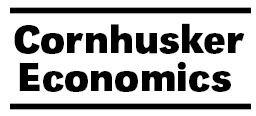Agricultural Economics, Department of

Cornhusker Economics
Date of this Version
3-11-2020
Document Type
Newsletter Issue
Citation
2020 Authors
Abstract
The market value of agricultural land in Nebraska increased by three percent over the prior year to an average of $2,730 per acre according to the 2020 Nebraska Farm Real Estate Market Survey (Figure 1 and Table 1). This improvement provides the first increase in the market value of agricultural land in Nebraska since peaking in 2014 at $3,315 per acre followed by a 20 per- cent decline extending to 2019.
The University of Nebraska-Lincoln, Department of Agricultural Economics annually surveys land industry professionals across Nebraska including appraisers, farm and ranch managers, and agricultural bankers. Results from the survey are divided by land class and summarized by the eight Agricultural Statistic Districts of Nebraska (Figure 2).
Professionals from the land industry participating in the annual survey reported the limited supply of land for sale, strong demand for purchases, and disaster as- sistance payments made to operators as driving forces providing stability to the market values. Due to the flooding of 2019, producers in Nebraska suffered around 421 thousand acres of prevented plant cropland with crop insurance covering a portion of these losses (USDA-FSA 2020). Also, depressed agricultural commodity prices in 2019 for farmers and ranchers due to global trade disruptions resulted in about $961 million of Marketing Facilitation Payments (MFP) across the state to offset undue trade retaliations (USDA-FSA 2020).
Crop and grazing land market values gradually increased in Nebraska for 2020 when compared to the prior year (Table 1). The estimated market value of dryland cropland rose approximately three to four percent with the Central, East, and Southeast Districts reporting increases exceeding five percent. Declines were noted in the Northwest and Southwest Districts where unpredicta- ble rainfall and regulations have placed moratoriums on the development of additional irrigated acres by producers.


Comments
agecon.unl.edu/cornhuskereconomics